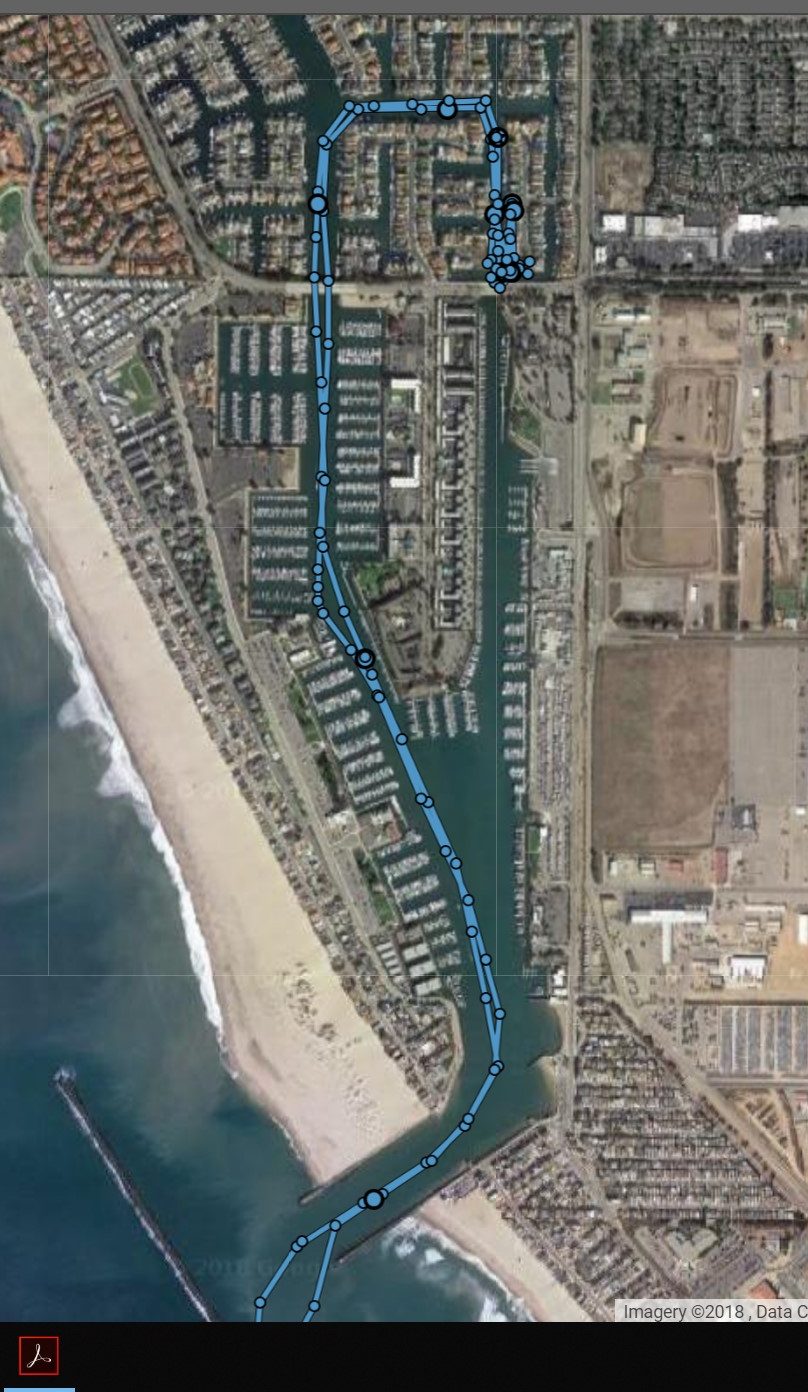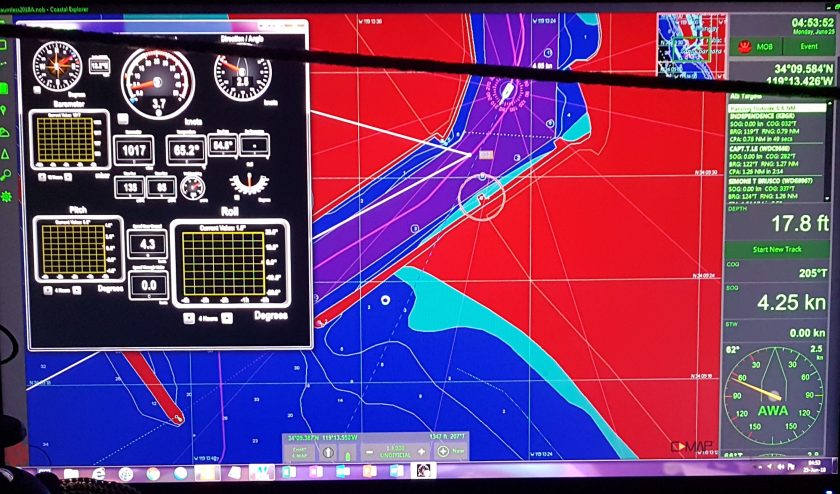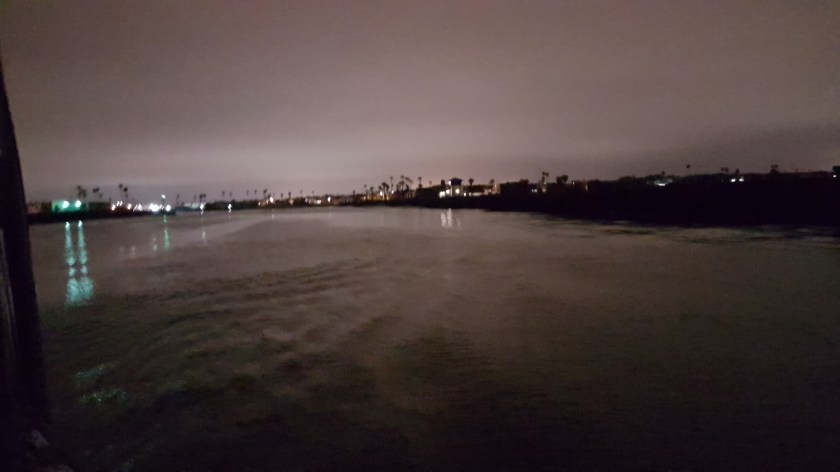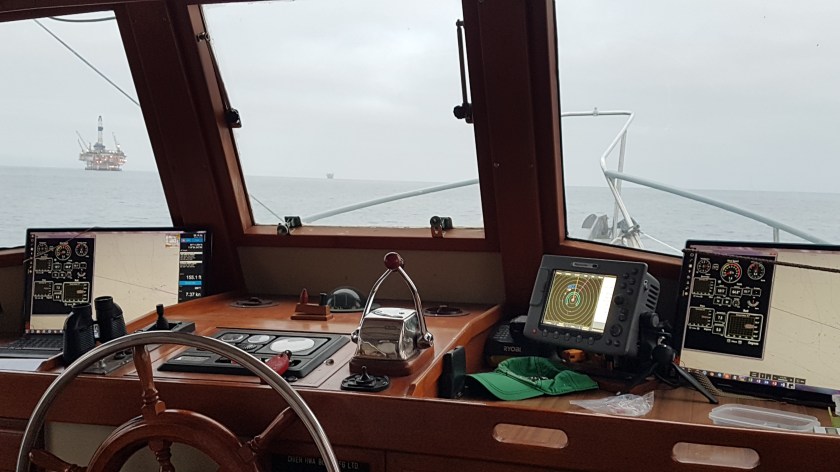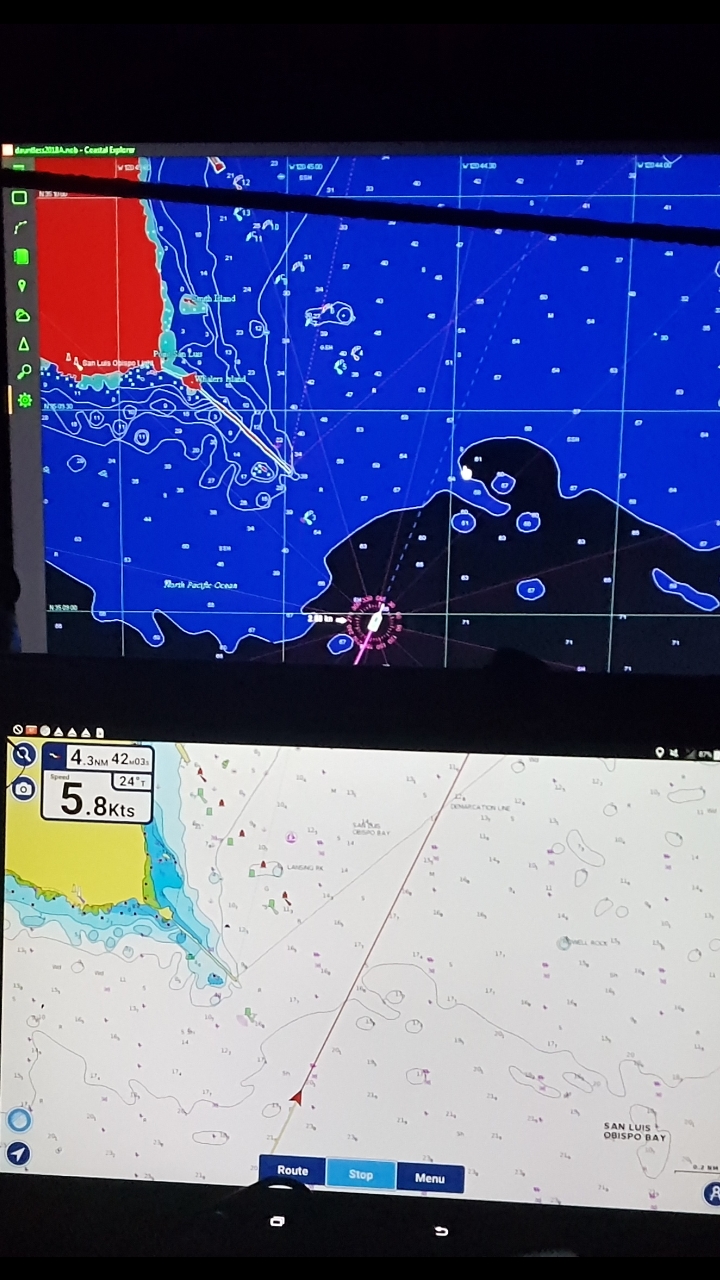A long, harrowing day was over. A good night’s sleep erased much of the drama. I was closer and closer to the end of this Baja bash.
07:25 I get up
07:30 I did my morning checks and log entries:
- Fuel: 3.25” port; 5.5” stbd
- Batts: Current draw -8 amps, 12.48v, -84 amp-hrs.
- H2O: 72-gal port, 82 gal stbd, feed stbd
- Oil: right on the full line
- ATF: 1 bar down, NC (Since I was still losing ATF, I checked this, normally I don’t)
07:53 Engine start, 6625.88 engine hours; Systems all Go.
07:58 Haul anchor
08:08 Anchor secured.
08:10 Underway to Morro Bay, following the track I came in on.
08:15 Do weather observation: Overcast Stratus Strata cu, Vis 2 miles fog, 1017mb 55° 51° 49° (sea temp) winds 27005
08:42 1700 rpms, 6.8 kts, slow to 1600, 6.4 kts, 1-2 ft swell on bow, larger swell 3-5 ft n bow. Pitch +4°/-4° Roll +6°/-3° benign.
09:25 1600, 6.5 kts, course 293°T, winds 27007 Pitch increased to +8/-8°
10:22 Change course to 016°, 1600 rpms, 6.2 kts, 3.5 nm to Morro Bay entrance. 7 knot winds on beam are producing a lazy roll of +10° (to stbd)/to -05° (to port).
11:30 Enter Morro Bay. Spot my first Sea Otters. Great. One more thing not to run over besides the ubiquitous paddle board and kayak people.

12:03 With a slow, almost idle, 4 kt approach (The minimum speed to have enough way to control boat), I approach the Morro Bay Yacht Club dock. It parallels the coast and there is ample room for me. I make a 180° to port (the direction this KK loves to turn) and am tied to the dock minutes later.
12:05 Docked at MBYC. An easy day, 3:55, 23 nm, 5.9 avg speed.
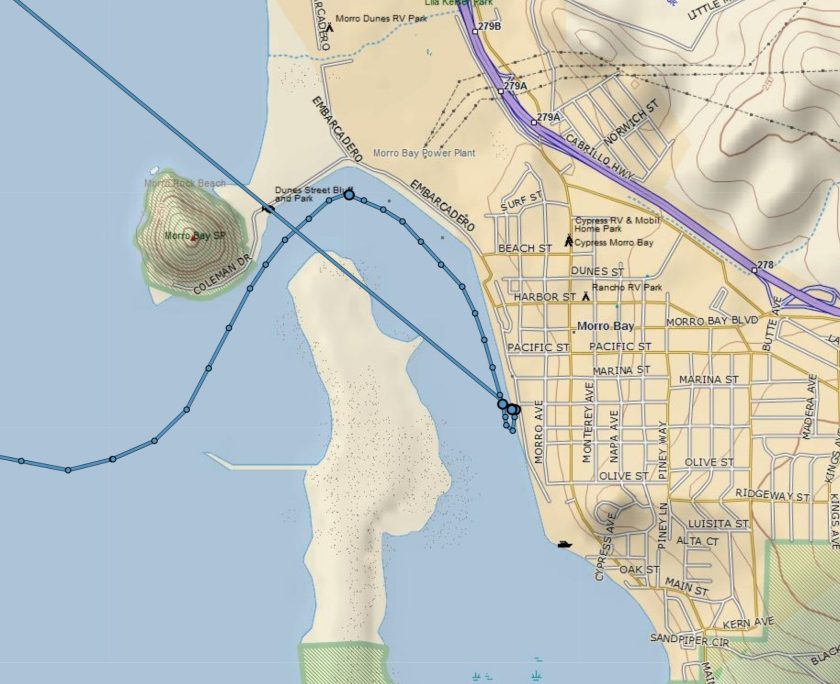
If you go to Share.Delorme. com/Dauntelss by clicking on the dot it gives you the speed, time and location, but times look converted. Thanks to Google, Garmin or Windows.
Morro Bay turned out to be a delight. Delightful people at the delightful Morro Bay Yacht Club (MBYC). If I was ever in one place long enough to join a yacht club, MBYC would be the kind of place I’d love to join. Having to wait out the weather for four days turned out nice. Really reasonably priced at $35 per day, it was a pleasure to be there. I felt good and knew that time wise, I’d be good to go if I could leave on the 30th.


I watched the winds every day and the forecasts were tracking well. I thought to leave Friday, but the winds were still up and while forecast to go down later in the day, this is a perfect example of when I say, “Don’t leave based on a forecast”. If your waiting for light winds, wait until you see light winds.
Also, MBYC had hamburger night Friday evening or maybe it was cocktail hour. In any case, I vowed to leave early Saturday morning, if winds were light as predicted.
Now the plan was getting down to hours. The anticipated 36-hour weather window showed light winds becoming increasing strong, but from the south as Saturday progressed into Sunday, but by Sunday afternoon, the northerlies would be back with a vengeance, 30+ knots west of the Golden Gate.
Additionally, the trip up San Francisco Bay must be timed for the currents and tides. The currents are as strong as hell’s Gate in NYC. So, I had to back up all my arrivals and departures so that I would arrive at the Golden Gate between 12:00 and 13:00 Sunday July 1st.
To get there at that time, I had to leave Santa Cruz before 03:00. So, if I wanted 5 hours sleep in Santa Cruz and a time to have dinner with some new boat friends who had their boat there, I had to leave MBYC at 01:00 to do the 121-mile trip in 18 hours, getting me to Santa Cruz by 18+1= 19:00
No problem. Just an early evening and get up at 01:00.

Notice the solar panel array on the port side stern of the sail boat in front of me.
Dauntless was parallel parked between two sailboats. The evening before I had asked about leaving that early, anything I needed to know. Everything seemed routine. I should be able to just push the bow out as I realized the last lines.
Maybe the sailors giving me this advice did not realize that Dauntless was 44,000 pounds? Certainly no one warned me about the current.
01:15 up, Saturday morning dawned with the expected light winds, I was ready to go.
01:20 As I did my routine combined current check and pee, it was obvious that the current was not insignificant.
The next 8 minutes were the most harrowing of the last three months.
It was obvious I couldn’t just undo the lines and push her out away from the dock and SV 15’ in front. Plan A was dead.
The stupid sailboat in front of me has two solar panels out behind his stern. On the first picture of this post, the sunset, the solar panel array is visible on the port side stern of the sail boat in front of me. They are probably 12 to 15 feet from my bow pulpit, which is 5 feet above them. But my hull will impact them before it hits anything else. No fender could protect them. This guy should be on a mooring.
Plan B: I untied all lines, but for the midship cleat. I wrapped it around the dock cleat near the stern, so it would slide thru once I released tension on my side. Meaning the line was secured to the boats stbd midship cleat, then back to the stern cleat on the dock and then I’m holding the bitter end in my hand while on the dock, near the pilot house door. The boat is in neutral at idle. For this to work, my plan is to give the bow a mighty push from the dock, releasing the line while I clamber on board.
With one mighty heave, I was truly seconds from disaster.
Dauntless was not moving out as much as I had hoped. I also was keenly aware that I was risking her leaving without me.
I clambered on board, as dauntless drifted forward crab like, her bow maybe 15 feet from the dock, stern still near the dock. I debated momentarily, for a split second at most, whether to just give her a shot of power, hoping that she would go straight out into the channel.
At 1.5 knots, that about 2 feet per second. In the 6 seconds it took me from release of the line, get on board and into pilot house, Dauntless moved 12 to 15 feet, the bow pulpit was almost over the left side of the sailboat. The stupid solar panels are a few feet from my stbd hull.
It was clear to me in a moment that if I gave it forward power, it would rake the entire starboard side of Dauntless against the stern port quarter of the SV.
I quickly put her in reverse and slightly increased power to 1100. I also had a sailboat behind me. I ran out to the bow, just in time to find off the stupid solar panels as the Kadey Krogen finally started to retreat.
I ran to the side deck to see what kind of room I now had behind me. I need to be tied to the dock I bought myself some more seconds by leaving her at idle in reverse. This gave me enough time to get to the side deck and get a line on the dock cleat. I made it tight and thought about what to do.
I took some needed breaths. I had to be calm now What were my options? It’s almost 1:30 in the morning. No one is getting up soon. On one hand it’s only a schedule, but being alone, makes the schedule even more important. If I didn’t leave now, I would be forced to run overnight. Which then has an impact the following day.
The Golden Gate timing was immutable.
I wanted to leave, but the idea that I start me day be destroying this boat’s solar panels would really fuck up my day.
I tied the boat thru the stern cleat to the dock’s cleat just a couple feet away.
I would try to push the bow out with the stern tied. I wouldn’t do anything else. Engine at idle, transmission neutral. It was just an experiment to see how far the bow would actually go out. If it went out to 45°, It would probably work.
It went to maybe 20°.
Tied again with a little more slack on the stern line, same results, but now she headed for those f…ing solar panels again like they were a magnet.
I had some seconds to spare this time, but I had to get her in reverse. We were still attached to the stern dock cleat. I had tied it so that while in reverse it did not have enough slack to hit the boat behind me. In other words, while I could watch the bow, I had to make sure when backing not to hit the boat just behind me.
Then I noticed an interesting phenomenon in reverse, attached to the stern cleat, the bow came out.!
That made perfect sense since Dauntless stern always wants to starboard. I need 2° of right rudder to go straight. In reverse, the prop walk is still to the right, to starboard, which is pone of the primary reasons, I always try to dock and tie on the starboard side.
(which in a recently found video has me backing into the slip in Golfito, Costa Rica. Once I figure out how to get it not inverted I will upload)
I checked the line on the dock and boat to make sure they were secure and then gave her more power in reverse. The bow keeps coming out more and more. This would work.
Back to idle, I quickly retied the stern line so that the closed loop was over the forward horn of the cleat. I then ran the line thru the stern hawse pipe forward inside the boat to the midships cleat.
I put the boat in reverse and added some power.
The bow came out further and further. Still in reverse, I sent down to the midships cleat, and took the line in my hand and walked it back to the pilot house door. With the line in my hand, I checked the port side to make sure it was still clear, gave her more power and the bow came well out.
Now, I knew the terrible downside of this plan. If that dock line snagged on something, at best it would slam the boat back to the dock hitting the boat ahead, at worse, I could drip the whole dock up, causing even more mayhem.
And I couldn’t check it. I still had to get the stern out to not hit the sailboat.
When it seemed, the bow would come out no more, I had to force myself to be slow and put her in idle, neutral, forward, power. Probably two to three seconds.
But remember at 2 feet per second forward due to current. In just doing that, reverse to forward, without slamming the damper plate, used half the distance between the two boats.
I stayed right behind the helm. I had to hope the line slipped off cleanly. As the solar panels were about two feet off the pilot house door, I swung the wheel hard right and goosed the power, to kick the stern out. The boat was still crabbing forward, so even with that maneuver, the stern only cleared by a few feet.
But she cleared. I hauled in the stern line quickly and turned on my driving lights to make sure I didn’t run over any sleeping sea otters.
01:28 Underway to Santa Cruz. I thanked every god I knew.
In hindsight, some thoughts:
- It’s a no-brainer that I should have just swapped positions with one of the two sailboats. Either being in the front or end, would have been leaving no problem. Also, everyone at the YC was so accommodating, it would have been no problem.
- Not as obvious is how the lack of a functional bow thruster affected this. It’s been three plus years now since by bow thruster stopped working. At least two times, we thought it was fixed, only to discover it wasn’t. But clearly, it hasn’t been a priority. Why?
- Before it stopped working, there were two memorable times when I needed it, but winds and currents overwhelmed it. Thus, it has seemed better to just learn to live without than to depend on something that may not work as well as hoped in the worst conditions.
- Be cause of that, I also stopped doing stuff because some marina or dock master suggested it. Now, I’ll say, “I don’t have a bow thruster, I can’t do that” Oh, no problem, we’ll put you on this “T” then! Duh!
- And now this experience reinforces my feelings that at least for me, I’m better off without it. My first thought was if the bow thruster was working this would have been easy. And therein lies the problem. I would have pushed the bow out, jumped on board, used the bow thruster without the understanding that the boat was moving 2 feet a second and while the bow would have missed, the broad side of the boat would have slammed into the stern of the sailboat. No way was it going to get out of the way in the 10 seconds I had.
- Yes, God certainly Watches Over Fools and Drunkards.
